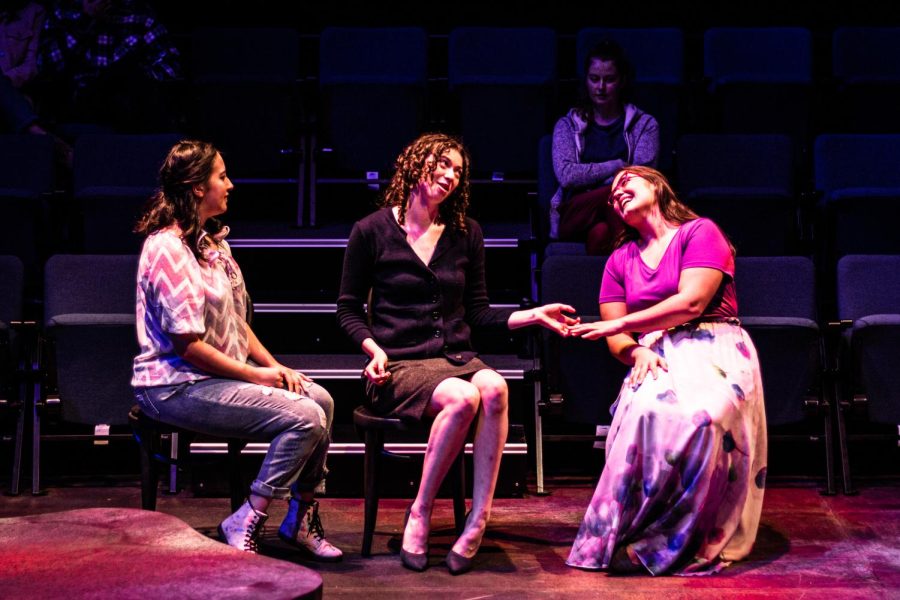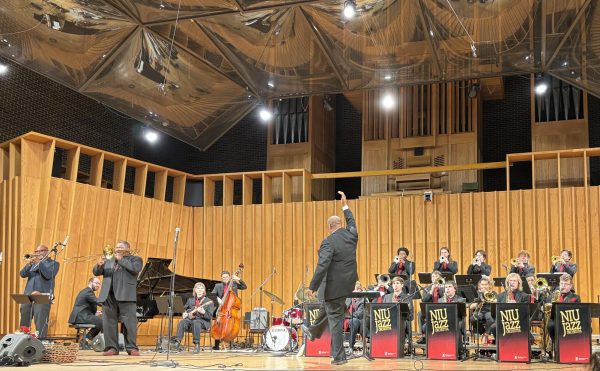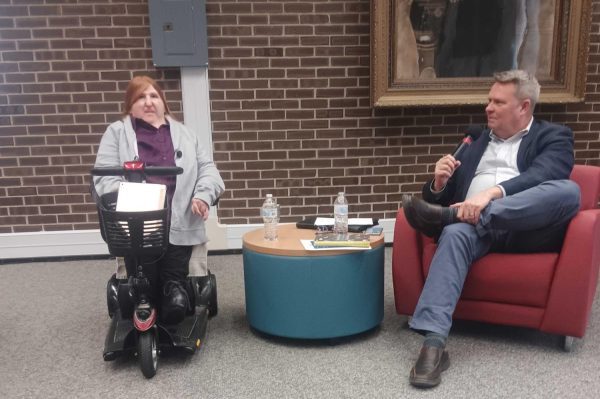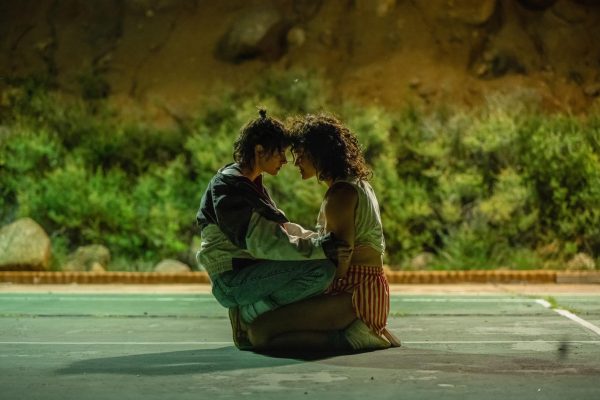NIU School of Theatre and Dance delivers intuitive experience with ‘Melancholy Play’
From left; Kristen Serbia, Naava Ofri-Akman and Gabby Gozdecki perform “Melancholy Play” at their final dress rehearsal. (Mingda Wu | Northern Star)
Editor’s note: This piece contains spoilers and discusses events that take place in “Melancholy Play.”
Students in NIU’s School of Theatre and Dance are performing “Melancholy Play,” by playwright Sarah Ruhl, this weekend in the school’s Black Box Theater. The play was directed by Bethany Mangum-Oles, a voice and movement faculty member in the SOTD.
What is melancholy? How does it affect those around us? When does melancholy mature into depression? Such questions are at the heart of this play; as is the meaning of reaching Ruhl’s self-described “almond state,” although what this actually means is up to interpretation.
PLAY OVERVIEW
The play’s central character, played by senior acting student Naava Ofri-Akman, is Tilly, a woman whose melancholy is so powerful that those who meet her can’t help but fall in love with her. This issue is one of the main driving points of the play.
One character named Frances, played by junior acting student Kristen Serbia, is so overwhelmed by feelings of unrequited love that she turns into an almond, much to the dismay of her friends and loved ones.
This almond-transformation is one of the main issues in the second act of the play; this comes about because it seems that as Tilly’s happiness increases, so do the negative consequences for her friends and loved ones. Her excessive happiness causes her to break up with her boyfriend Frank, played by senior acting student Wesley Hutchinson. Furthermore, Tilly’s happiness has her stop seeing her therapist Lorenzo, played by senior acting student Matthew Judd, which puts him in a state of distress.
Toward the end of the play, Joan, played by sophomore acting student Gabby Gozdecki, convinces Tilly to help her figure out what to do because Joan’s partner Frances is now an almond. All the cast rally together to Frances’ aid, and shocking truths and secrets are revealed.
The ending itself is somewhat ambiguous, but the characters appear genuinely happy because they are all together. Each cast member did a stunning job bringing their character to life, and overall, the audience appeared happy with the play and the actors’ performance.
STAGE AND DESIGN
The stage itself had a minimalist design and was close to the audience, giving the theater a very intimate feeling. The acoustics in the room add to the feeling of intensity, letting the actors’ voices carry far and really making you feel like you were experiencing life right alongside them.
The stage itself was covered in watercolor inkblot shapes. Eric Brockmeier, a second-year scenic design graduate student, said, “I really wanted to play with the different senses and levels of melancholy that we see.”
Brockmeier was inspired by the inkblot cards often seen in therapist offices. The blots on stage were done meticulously and worked well with the lighting in the room to create a good ambiance. Brockmeier designed the entryway into the stage, which the audience had to pass through, and which contained different mementos of Tilly’s life. This really helped to visualize Tilly’s headspace. Overall, Brockmeier and the team did a good job with the set pieces, complementing the emotion and overall mood of the performance.
THOUGHTS FROM ACTORS
All of the actors really connected with their characters, although Serbia admits she didn’t initially get the point of turning into an almond.
“After reading it a few times, I really found that, for Frances, the almond state was just, like, a sense of peace and finding peace that she has been looking for a long time,” Serbia said.
Judd, whose performance of Lorenzo was riveting and emotionally driven, discussed in the after-show talk that he did a lot of research on being a psychiatrist to help build a connection with his character. Although he jokingly admitted that he wouldn’t want to be one in real life, Judd wanted to get a sense of how psychiatrists composed themselves and how they walked and talked.
For Ofri-Akman, the character of Tilly was more about the perception of Tilly rather than Tilly herself.
“(This perception) changed how I thought of the character, I’m more creating this illusion of Tilly. I think I find moments to express her, but it’s a little more drippy, a little more performative, which means it’s in the style of the show. Everyone wants to have these big expressive moments that are larger than life,” Ofri-Akman said.
Hutchinson praised the depth of Ruhl’s work. He really appreciated how the characters interacted with one another and how they changed throughout the play. Hutchinson really connected with his character Frank and discussed how he liked his character’s journey.
Another aspect that really speaks to the wonderful depth of this play is the music and score, which really helped set the tone throughout the play. For this run of the play, the musical score was done by graduate cello student Brandon Rittenour. When originally approached, Rittenour asked, “What’s the score? I kind of wanted to see what I was getting into and they told me there is no score, you’ve got to write (it) yourself; and the beauty of that is that every new production of this play is its own unique product.”
Rittenour discussed the creative process of scoring this play. “I really wanted to be involved in the rehearsal process to make sure what I was feeling matched what they were creating. In essence I wanted to create a motif that was both like lilty and introspective but also (had) the ability to be more aggressive,” Rittenour said.
I really enjoyed my experience at the theater. Although the intimacy of the stage set-up was a little jarring at times, I think it really lets you connect on an emotional level with the characters. I also really enjoyed how collaborative the whole team was in creating this masterpiece. The actors and production team were really on point and helped deliver a seamless and intuitive experience. I would definitely recommend this show and would see it again, perhaps a few rows further from the stage next time.
The play will have additional performances from Sept. 29 to Oct. 1. Tickets are free for NIU students. For community members interested in getting tickets, contact the box office for the School of Theatre and Dance or go online.

















